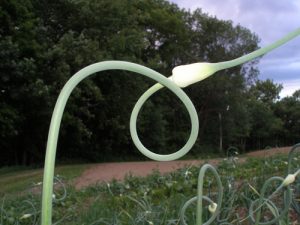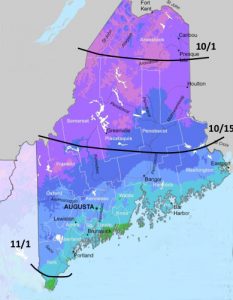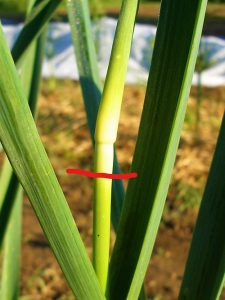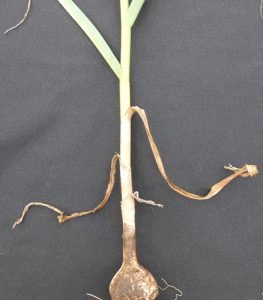Bulletin #2063, Growing Garlic in Maine
Bulletin #2063, Growing Garlic in Maine (PDF)
Developed by David Fuller, Extension Professional and Steven B. Johnson, Extension Crops Specialist
Reviewed by Frank Wertheim, Extension Educator
For information about UMaine Extension programs and resources, visit extension.umaine.edu.
Find more of our publications and books at extension.umaine.edu/publications/.
Table of Contents:
- Garlic Biology
- Cultivating Garlic
- VIDEO: How Do I Grow Garlic in Maine (YouTube)
- VIDEO: Garlic in the Home Garden: Removing Scapes (YouTube)
- Harvest
- VIDEO: Harvesting and Drying Hardneck Garlic (YouTube)
- Curing
- Storage
- VIDEO: Storing Garlic (YouTube)
- Future Crops
Garlic is a member of the Allium family, which includes onions, chives, and leeks. Garlic originated in central Asia and has been grown for 5,000 years in Egypt and India. Found as an important ingredient in many cuisines, garlic is an easy-to-grow crop that is increasingly popular in Maine. Garlic is generally the last crop planted in the fall and the first to emerge in the spring, extending the time you can enjoy being in the garden.
Garlic Biology
Garlic is a perennial bulb that is grown vegetatively from cloves because it rarely produces true seed. The two most common subspecies of garlic seen in Maine are softneck garlic, Allium sativum ssp. sativum, and hardneck garlic, Allium sativum ssp. ophioscorodon — from the Greek words ophis for serpent (after the coiled growth of garlic scapes), and scorodon for garlic.
Hardneck garlic (also known as stiffneck, ophio, or topset garlic) bears a stiff stalk called a scape. The scapes of most hardneck varieties each produce an umbel: a reproductive body bearing round clones called bulbils, and sometimes floral parts, depending on the variety. Softneck garlic does not produce a scape. Elephant garlic, a member of the leek family, is not a true garlic. Softneck garlic and elephant garlic are not reliably hardy throughout Maine so they will not be discussed here.
Cultivating Garlic
Site selection
Hardneck garlic grows best in the day-long sun in soil that is well-drained, with a pH of about 6.5 and good soil organic matter (5 to 8 percent).
Planting stock
Seed garlic can be obtained from reliable sources such a farmer’s markets, garlic seed producers, or seed catalogs. The garlic sold in supermarkets is almost always softneck garlic, usually from California or China, and is not recommended for planting in Maine. Planting stock should be free from disease and pests such as white rot and garlic bloat nematode. Obtain planting stock from reliable sources.
All hardneck garlic varieties do well in Maine. Some popular choices include German Extra Hardy, Russian Red, Chesnok Red, Music, Phillips, and Italian Purple.
Fertility Requirements
Preplanting fertility
Major soil nutrients, pH, and soil organic matter levels can readily be determined with a standard soil test, which is highly recommended. Garlic is a heavy feeder of nitrogen, phosphate, and potassium (N-P-K). In the absence of a soil test, mix 10-10-10 fertilizer (containing 10 percent each of nitrogen, phosphate, and potassium), or organic equivalent, into the soil to a depth of 6 inches before planting, at the rate of 5 tablespoons for each six-clove bulb.
Sidedress fertility
Additional nitrogen at one-quarter the pre-planting rate should be applied twice on top of the soil or mulch in the spring: once at plant emergence and again two to three weeks later. Simply sprinkle fertilizer beside the plants and water it in well. This additional nitrogen supports the development of healthy green tops, which helps to produce larger bulbs. Later applications of nitrogen are not helpful as they may reduce the storage life of harvested bulbs. Additional phosphate and potassium are not needed in the spring.
Planting
In Maine, hardneck garlic is planted from cloves. The goal in the timing of planting is to allow the clove to establish a root system but not to plant so early as to have the top emerge above the soil line where it is prone to winter injury. Plant hardneck garlic cloves in Maine about mid-September to the end of October, north to south. (See figure below.) Spring-planted garlic does not attain the size of fall-planted garlic. If you want to produce large bulbs, plant large cloves.1 Planting smaller cloves will produce smaller bulbs.
Spacing/depth
Separate garlic bulbs into individual cloves shortly before planting. The cloves should be planted with their pointed ends up so the clove point is 2 to 4 inches from the soil surface. Space cloves 4 to 6 inches apart within rows, and space rows from 6 to 12 inches apart. A dibble will help form planting holes. Closer spacing will produce smaller garlic bulbs, while wider spacing will produce larger bulbs. After planting, smooth over the soil surface.
Mulch
Mulch is recommended for garlic plantings in Maine. Mulch will moderate the thaw/freeze cycles of the soil and potential heaving of the cloves. It will also reduce weed pressure and help conserve moisture. Some mulch choices are dried grass, leaves, or straw. Straw will provide excellent weed control and should be relatively free of weeds, unlike most hay. Apply mulch to a thickness of three inches.
Weed control
Garlic does not compete well with weeds for light and nutrition. Weed-free plantings produce larger bulbs. Control weeds when they are small and manageable. Large weeds can disrupt garlic bulbs when pulled.
Scape removal
Hardneck garlic will produce a scape from the center whorl of leaves in June. University of Maine research has shown that leaving the scape on the plant will reduce the eventual size of the harvested bulb by as much as 48%.2 Removing the scape will not interfere with the in-season growth or the storage life of the harvested bulb. The scape should be removed when the bulbil body—the thickening of the scape located just behind the tip—can be removed (see image). It is best to remove the scape early in its development, rather than waiting until the scape further elongates and curls as harvesting at this later point reduces the harvested bulb size by 9% (Fuller, unpublished data). Young chopped scapes can be used in cooking to provide mild garlic flavor or to make pesto. They are also attractive in flower arrangements.
Pests
Garlic is relatively free of pest and disease problems. White rot and garlic bloat nematode, two of the most serious garlic pests, are spread by infected bulbs and can be avoided by obtaining planting stock from reliable sources or using your own pest-free stock. Storage diseases can be avoided by promptly drying harvested bulbs and storing them properly.
Record-keeping
It’s always a good idea to keep a record of your crops, including garlic. Note variety(s) planted, source of stock, planting and harvest dates, and successes or problems encountered.
Harvest
Hardneck garlic should be harvested when the bulbs are fully mature. Harvest time corresponds with the browning of the lowermost leaves. When the lower three leaves have turned brown, you have about two weeks to harvest your garlic. Beyond that time, the outer wrapper of the bulb will disintegrate, eventually leaving bare cloves that will not store well or be suitable for sale or as gifts.
To harvest, loosen mature garlic by under-digging with a spade or spading fork, taking care not to damage the bulbs. Pull the whole plant and shake off loose soil. Let the garlic field dry for a day in the garden, then lightly brush off any remaining loose soil and bring the garlic into a well-ventilated space, like a garage or barn. Washing is not recommended, as the goal now is to dry the garlic as quickly as possible to avoid disease development during the curing and storing of the crop.
Curing
Curing is the process of drying garlic bulbs to prepare for storage. Garlic tops may be removed at any time during or after harvesting. Cut the garlic tops, leaving about one and one-half inches of stem at the top of the bulb. Garlic is best cured in a single layer, in a warm, dry place with good air movement. Drying racks with mesh screen and a fan will provide the best conditions. Don’t cure garlic in a very hot place, like an attic, closed greenhouse, or in direct sunlight. Garlic should be well-dried in three to four weeks when it can be moved to a storage location.
Storage
Garlic is best stored cool and dry. Store it in your home in a dark place, ideally at temperatures of about 60°F with a relative humidity of about 50 percent. Cooler, moister conditions promote sprouting and will diminish storage time. Never refrigerate garlic or store garlic in a plastic bag.
Future Crops
When harvesting your garlic, save your largest, healthiest bulbs for planting that fall. This planting stock will save you money and time, and you’ll have the satisfaction of planting your own garlic to repeat the cycle of planting and harvest.
Resources
1 MAC-projects-2014-2015.pdf (umaine.edu) (page 13-15)
2 Maine Agricultural Center Grant MAC 120 report
Information in this publication is provided purely for educational purposes. No responsibility is assumed for any problems associated with the use of products or services mentioned. No endorsement of products or companies is intended, nor is criticism of unnamed products or companies implied.
© 2013, 2022
Call 800.287.0274 (in Maine), or 207.581.3188, for information on publications and program offerings from University of Maine Cooperative Extension, or visit extension.umaine.edu.
In complying with the letter and spirit of applicable laws and pursuing its own goals of diversity, the University of Maine System does not discriminate on the grounds of race, color, religion, sex, sexual orientation, transgender status, gender, gender identity or expression, ethnicity, national origin, citizenship status, familial status, ancestry, age, disability physical or mental, genetic information, or veterans or military status in employment, education, and all other programs and activities. The University provides reasonable accommodations to qualified individuals with disabilities upon request. The following person has been designated to handle inquiries regarding non-discrimination policies: Director of Institutional Equity and Title IX Services, 5713 Chadbourne Hall, Room 412, University of Maine, Orono, ME 04469-5713, 207.581.1226, TTY 711 (Maine Relay System).





